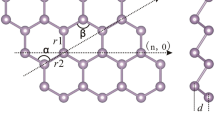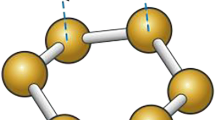Abstract
In this paper, the vibrational characteristics of zigzag phosphorene nanotubes are investigated by using a three-dimensional finite element model. The beam elements are used to simulate the P–P bonds in the structure of the phosphorene nanotubes. The elastic properties of the beam elements are computed from the similarity of energy terms in the molecular and structural mechanics. Besides, mass elements are located at the place of the atoms. Considering the zigzag phosphorene nanotubes with different diameters, it is shown that the effect of the diameter on the first natural frequencies of the nanotubes can be neglected. However, this effect increases for higher modes. Besides, at the same diameter, the zigzag phosphorene nanotubes with larger aspect ratios (length/diameter) have smaller frequencies.














Similar content being viewed by others
References
H. Liu, A.T. Neal, Z. Zhu, Z. Luo, X. Xu, D. Tománek, P.D. Ye, Phosphorene: an unexplored 2D semiconductor with a high hole mobility. ACS Nano 8, 4033–4041 (2014)
L. Li, Y. Yu, G.J. Ye, Q. Ge, X. Ou, H. Wu, D. Feng, X.H. Chen, Y. Zhang, Black phosphorus field-effect transistors. Nat. Nanotechnol. 9, 372–377 (2014)
S.P. Koenig, R.A. Doganov, H. Schmidt, A.C. Neto, B. Oezyilmaz, Electric field effect in ultrathin black phosphorus. Appl. Phys. Lett. 104, 103106 (2014)
Y.Y.W. Ding, L. Shi, Z. Xu, J. Ni, Anisotropic elastic behaviour and one-dimensional metal in phosphorene, physica status solidi. Rapid Res. Lett. 8, 939–942 (2014)
T. Hu, Y. Han, J. Dong, Mechanical and electronic properties of monolayer and bilayer phosphorene under uniaxial and isotropic strains. Nanotechnology 25, 455703 (2014)
Q. Wei, X. Peng, Superior mechanical flexibility of phosphorene and few-layer black phosphorus. Appl. Phys. Lett. 104, 251915 (2014)
L. Wang, A. Kutana, X. Zou, B.I. Yakobson, Electro-mechanical anisotropy of phosphorene. Nanoscale 7, 9746–9751 (2015)
G. Wang, G.C. Loh, R. Pandey, S.P. Karna, Out-of-plane structural flexibility of phosphorene. Nanotechnology 27, 055701 (2015)
C.X. Wang, C. Zhang, J.W. Jiang, H.S. Park, T. Rabczuk, Mechanical strain effects on black phosphorus nanoresonators. Nanoscale 8, 901–905 (2016)
Z.D. Sha, Q.X. Pei, Z. Ding, J.W. Jiang, Y.W. Zhang, Mechanical properties and fracture behavior of single-layer phosphorene at finite temperatures. J. Phys. D Appl. Phys. 48, 395303 (2015)
Z.D. Sha, Q.X. Pei, Z. Ding, J.W. Jiang, Y.W. Zhang, Atomic vacancies significantly degrade the mechanical properties of phosphorene. Nanotechnology 27, 315704 (2016)
N. Liu, J. Hong, R. Pidaparti, X. Wang, Fracture patterns and the energy release rate of phosphorene. Nanoscale 8, 5728–5736 (2016)
V. Sorkin, Y.W. Zhang, The structure and elastic properties of phosphorene edges. Nanotechnology 26, 235707 (2015)
V. Sorkin, Y.W. Zhang, The deformation and failure behaviour of phosphorenenanoribbons under uniaxial tensile strain. 2D Mater. 2, 035007 (2015)
V. Sorkin, Y.W. Zhang, Mechanical properties of phosphorene nanotubes: a density functional tight-binding study. Nanotechnology 27, 395701 (2016)
X. Liao, F. Hao, H. Xiao, X. Chen, Effects of intrinsic strain on the structural stability and mechanical properties of phosphorene nanotubes. Nanotechnology 27, 215701 (2016)
G. Seifert, E. Hernandez, Theoretical prediction of phosphorus nanotubes. Chem. Phys. Lett. 318, 355–360 (2000)
I. Cabria, J.W. Mintmire, Stability and electronic structure of phosphorus nanotubes. Europhys. Lett. 65, 82–88 (2004)
W. Ju, T. Li, H. Wang, Y. Yong, J. Sun, Strain-induced semiconductor to metal transition in few-layer black phosphorus from first principles. Chem. Phys. Lett. 622, 109–114 (2015)
J.W. Jiang, H.S. Park, Analytic study of strain engineering of the electronic bandgap in single-layer black phosphorus. Phys. Rev. B91, 235118 (2015)
X. Han, H.M. Stewart, S.A. Shevlin, C.R.A. Catlow, Z.X. Guo, Strain and orientation modulated bandgaps and effective masses of phosphorenenanoribbons. Nano Lett. 14, 4607–4614 (2014)
Y. Guo, S. Zhou, J. Zhang, Y. Bai, J. Zhao, Atomic structures and electronic properties of phosphorene grain boundaries. 2D Mater. 3, 025008 (2016)
R. Zhang, B. Li, J. Yang, A first-principles study on electron donor and acceptor molecules adsorbed on phosphorene. J. Phys. Chem. C 119, 2871–2878 (2015)
L.C. Xu, X.J. Song, Z. Yang, L. Cao, R.P. Liu, X.Y. Li, Phosphorene nanoribbons: passivation effect on bandgap and effective mass. Appl. Surf. Sci. 324, 640–644 (2015)
Q. Wu, L. Shen, M. Yang, Y. Cai, Z. Huang, Y.P. Feng, Electronic and transport properties of phosphorene nanoribbons. Phys. Rev. B 92, 035436 (2015) Author: As References [25] and [26]; [32] and [33] are same, we have deleted the duplicate reference and renumbered accordingly. Please check and confirm. From: Saeed Rouhi Sent: Sunday, March 19, 2017 3:31:47 AM (UTC+05:30) Chennai, Kolkata, Mumbai, New Delhi To: Subramaniam, Jayagopal Subject: Corrected Proof (APYA-D-16-01953.1) Article Title : A density functional theory-based finite element method to study the vibrational characteristics of zigzag phosphorene nanotubes DOI : 10.1007/s00339-017-0860-2 APYA-D-16-01953.1 Dear Editor The corrected Proof is attached. Regards Saeed Rouhi
P. Dou-Xing, W. Tzu-Chiang, G. Wan-Lin, Bending-induced phase transition in monolayer black phosphorus Project supported by the National Natural Science Foundation of China (Grant Nos. 11021262, 11172303, and 11132011) and the National Basic Research Program of China (Grant No. 2012CB937500). Chin. Phys. B 24, 086401 (2015)
L. Guan, G. Chen, J. Tao, Prediction of the electronic structure of single-walled black phosphorus nanotubes. Phys. Chem. Chem. Phys. 18, 15177–15181 (2016)
Z.Y. Ong, Y. Cai, G. Zhang, Y.W. Zhang, Strong thermal transport anisotropy and strain modulation in single-layer phosphorene. J. Phys. Chem. C 118, 25272–25277 (2014)
T.H. Liu, C.C. Chang, Anisotropic thermal transport in phosphorene: effects of crystal orientation. Nanoscale 7, 10648–10654 (2015)
J.W. Jiang, Thermal conduction in single-layer black phosphorus: highly anisotropic. Nanotechnology 26, 055701 (2015)
Y. Hong, J. Zhang, X. Huang, X.C. Zeng, Thermal conductivity of a two-dimensional phosphorene sheet: a comparative study with grapheme. Nanoscale 7, 18716–18724 (2015)
W. Xu, G. Zhang, Remarkable reduction of thermal conductivity in phosphorene phononic crystal. J. Phys. Condens. Matter 28, 175401 (2016)
F. Hao, X. Liao, H. Xiao, X. Chen, Thermal conductivity of armchair black phosphorus nanotubes: a molecular dynamics study. Nanotechnology 27, 155703 (2016)
Y.Y. Zhang, Q.X. Pei, J.W. Jiang, N. Wei, Y.W. Zhang, Thermal conductivities of single-and multi-layer phosphorene: a molecular dynamics study. Nanoscale 8, 483–491 (2016)
H. Sun, G. Liu, Q. Li, X.G. Wan, First-principles study of thermal expansion and thermomechanics of single-layer black and blue phosphorus. Phys. Lett. A 380, 2098–2104 (2016)
Y. Jing, Q. Tang, P. He, Z. Zhou, P. Shen, Small molecules make big differences: molecular doping effects on electronic and optical properties of phosphorene. Nanotechnology 26, 095201 (2015)
T. Hu, A. Hashmi, J. Hong, Geometry, electronic structures and optical properties of phosphorus nanotubes. Nanotechnology 26, 415702 (2015)
A. Hashmi, U. Farooq, J. Hong, Graphene/phosphorene bilayer: high electron speed, optical property and semiconductor-metal transition with electric field. Curr. Appl. Phys. 16, 318–323 (2016)
L.J. Kong, G.H. Liu, Y.J. Zhang, Tuning the electronic and optical properties of phosphorene by transition-metal and nonmetallic atom co-doping. RSC Adv. 6, 10919–10929 (2016)
D. Çakır, H. Sahin, F.M. Peeters, Tuning of the electronic and optical properties of single-layer black phosphorus by strain. Phys. Rev. B 90, 205421 (2014)
H. Zheng, H. Yang, H. Wang, X. Du, Y. Yan, Electronic and magnetic properties of nonmetal atoms doped blue phosphorene: first-principles study. J. Magn. Magn. Mater. 408, 121–126 (2016)
L. Viti, J. Hu, D. Coquillat, A. Politano, C. Consejo, W. Knap, S.M. Vitiello, Heterostructured hBN-BP-hBN nanodetectors at terahertz frequencies. Adv. Mater. 34, 7293 (2016)
L. Viti, J. Hu, D. Coquillat, W. Knap, A. Tredicucci, A. Politano, M.S. Vitiello, Black phosphorus terahertz photodetectors. Adv. Mater. 27, 5567–5572 (2015)
D. Wang, G.C. Guo, X.L. Wei, L.M. Liu, S. Zhao, Phosphorene ribbons as anode materials with superhigh rate and large capacity for Li-ion batteries. J. Power Sources 302, 215–222 (2016)
Z. Jingxiang, Y. Yang, R.S. Katiyar, Z. Chen, Phosphorene as a promising anchoring material for lithium–sulfur batteries: a computational study. J. Mater. Chem. A 4, 6124–6130 (2016)
S. Zhao, W. Kang, J. Xue, The potential application of phosphorene as an anode material in Li-ion batteries. J. Mater. Chem. A 2, 19046–19052 (2014)
V.V. Kulish, O.I. Malyi, C. Persson, P. Wu, Phosphorene as an anode material for Na-ion batteries: a first-principles study. Phys. Chem. Chem. Phys. 17, 13921–13928 (2015)
N. Suvansinpan, F. Hussain, G. Zhang, C.H. Chiu, Y. Cai, Y.W. Zhang, Substitutionally doped phosphorene: electronic properties and gas sensing. Nanotechnology 27, 065708 (2016)
M.Z. Rahman, C.W. Kwong, K. Davey, S.Z. Qiao, 2D phosphorene as a water splitting photocatalyst: fundamentals to applications. Energy Environ. Sci. 9, 709–728 (2016)
H. Du, Xi.. Lin, Z. Xu, D. Chu, Recent developments in black phosphorus transistors. J. Mater. Chem. C 3, 8760–8775 (2015)
C. Li, T.W. Chou, Single-walled nanotubes as ultra high frequency nanomechanical resonators. Phys. Rev. B 68, 073405 (2003)
J.A. Roberts, T. Imholt, Z. Ye, C.A. Dyke, D.W. Price, J.M. Tour, Electro-magnetic wave properties of polymer blends of single wall carbon nanotubes using a resonant microwave cavity as a probe. J. Appl. Phys. 95(8), 4352–4356 (2004)
M. Dequesnes, Z. Tang, N.R. Aluru, Static and dynamic analysis of carbon nanotube-based switches. J. Eng. Mater. Technol. 126, 230–237 (2004)
P. Dharap, Z. Li, S. Nagarajaiah, E.V. Barrera, Nanotube film based on singlewalled carbon nanotubes for strain sensing. Nanotechnology 15, 379–382 (2004)
C.K.M. Fung, M.Q.H. Zhang, R.H.M. Chan, W.J. Li, A PMMA-based micro pressure sensor chip using carbon nanotubes as sensing elements. Proc. MEMS 251–254 (2005)
R.J. Grow, Q. Wang, J. Cao, D. Wang, H. Dai, Piezoresistance of carbon nanotubes on deformable thin-film membranes. Appl. Phys. Lett. 86, 93104–93107 (2005)
M. Nishio, S. Sawaya, S. Akita, Y. Nakayama, Carbon nanotube oscillators towards zeptogram detection. Appl. Phys. Lett. 86(1–3), 133111 (2005)
S.J. Papadakis, A.R. Hall, P.A. Williams, L. Vicci, M.R. Falvo, R. Superfine, S. Washburn, Resonant oscillators with carbon-nanotube torsion springs. Phys. Rev. Lett. 93(14), 146101 (2004). (1–4)
R. Ansari, S. Rouhi, M. Aryayi, Nanoscale finite element models for vibrations of single-walled carbon nanotubes: atomistic versus continuum. Appl. Math. Mech. 34, 1187–1200 (2013)
G.M. Odegard, T.S. Gates, L.M. Nicholson, K.E. Wise, Equivalent-continuum modeling of nano-structured materials. Compos. Sci. Technol. 62, 1869–1880 (2002)
B.R. Gelin, Molecular modeling of polymer structures and properties. Hanser Publishers; Hanser/Gardner Publications, Munich (1994)
T. Chang, H. Gao, Size-dependent elastic properties of a single-walled carbon nanotube via a molecular mechanics model. J. Mech. Phys. Solids 51, 1059–1074 (2003)
R. Ansari, S. Rouhi, Atomistic finite element model for axial buckling of single-walled carbon nanotubes. Phys. E Low-dimens. Syst. Nanostruct. 43(2010)58–69
S. Rouhi, R. Ansari, Atomistic finite element model for axial buckling and vibration analysis of single-layered graphene sheets. Phys. E Low-dimens. Syst. Nanostruct. 44, 764–772 (2012)
R. Ansari, S. Rouhi, M. Aryayi, M. Mirnezhad, On the buckling behavior of single-walled silicon carbide nanotubes. ScientiaIranica 19, 1984–1990 (2012)
R. Ansari, S. Rouhi, M. Mirnezhad, M. Aryayi, Stability characteristics of single-layered silicon carbide nanosheets under uniaxial compression. Phys. E Low-dimens. Syst. Nanostruct. 53, 22–28 (2013)
R. Ansari, S. Rouhi, M. Mirnezhad, M. Aryayi, Stability characteristics of single-walled boron nitride nanotubes. Arch. Civil Mech. Eng. 15, 162–170 (2015)
R. Ansari, A. Shahnazari, S. Rouhi, A density-functional-theory-based finite element model to study the mechanical properties of zigzag phosphorene nanotubes. Phys. E Low-dimens. Syst. Nanostruct. 88, 272–278 (2017)
C. Li, T.W. Chou, Mass detection using carbon nanotube-based nanomechanical resonators. Appl. Phys. Lett. 84, 5246–5248 (2004)
Author information
Authors and Affiliations
Corresponding authors
Rights and permissions
About this article
Cite this article
Shahnazari, A., Ansari, R. & Rouhi, S. A density functional theory-based finite element method to study the vibrational characteristics of zigzag phosphorene nanotubes. Appl. Phys. A 123, 263 (2017). https://doi.org/10.1007/s00339-017-0860-2
Received:
Accepted:
Published:
DOI: https://doi.org/10.1007/s00339-017-0860-2




